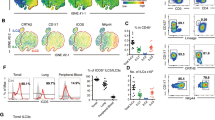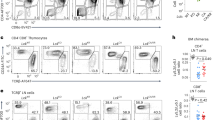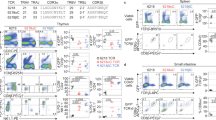Abstract
T helper type 1 (TH1) immune responses are central in cell-mediated immunity, and a TH1-specific cell surface molecule called Tim-3 (T cell immunoglobulin domain, mucin domain) has been identified. Here we report the identification of a secreted form of Tim-3 that contains only the immunoglobulin (Ig) variable (V) domain of the full-length molecule. Fusion proteins (Tim-3–Ig) of both Tim-3 isoforms specifically bound CD4+ T cells, indicating that a Tim-3 ligand is expressed on CD4+ T cells. Administration of Tim-3–Ig to immunized mice caused hyperproliferation of TH1 cells and TH1 cytokine release. Tim-3–Ig also abrogated tolerance induction in TH1 cells, and Tim-3-deficient mice were refractory to the induction of high-dose tolerance. These data indicate that interaction of Tim-3 with Tim-3 ligand may serve to inhibit effector TH1 cells during a normal immune response and may be crucial for the induction of peripheral tolerance.
This is a preview of subscription content, access via your institution
Access options
Subscribe to this journal
Receive 12 print issues and online access
$209.00 per year
only $17.42 per issue
Buy this article
- Purchase on Springer Link
- Instant access to full article PDF
Prices may be subject to local taxes which are calculated during checkout






Similar content being viewed by others
References
Mosmann, T., Cherwinski, H., Bond, M., Giedlin, M. & Coffman, R. Two types of murine helper T cell clone. I. Definition according to profiles of lymphokine activities and secreted proteins. J. Immunol. 136, 2348–2357 (1986).
Mosmann, T. & Sad, S. The expanding universe of T-cell subsets: TH1, TH2 and more. Immunol. Today 19, 138–146 (1996).
Abbas, A., Murphy, K. & Sher, A. Functional diversity of helper T lymphocytes. Nature 383, 787–793 (1996).
Sher, A. & Coffman, R. Regulation of immunity to parasites by T cells and T cell-derived cytokines. Annu. Rev. Immunol. 10, 385–409 (1992).
Liblau, R., Singer, S. & McDevitt, H. TH1 and TH2 CD4+ T cells in the pathogenesis of organ-specific autoimmune diseases. Immunol. Today 16, 34–38 (1995).
Nicholson, L., Greer, J., Sobel, R., Lees, M. & Kuchroo, V. An altered peptide ligand mediates immune deviation and prevents autoimmune encephalomyelitis. Immunity 3, 397–405 (1995).
Kuchroo, V. et al. B7-1 and B7-2 costimulatory molecules activate differentially the TH1/TH2 developmental pathways: application to autoimmune disease therapy. Cell 80, 707–718 (1995).
Lack, G. et al. Nebulized but not parenteral IFN-γ decreases IgE production and normalizes airways function in a murine model of allergen sensitization. J. Immunol. 152, 2546–2554 (1994).
Hofstra, C. et al. Prevention of TH2-like cell responses by coadministration of IL-12 and IL-18 is associated with inhibition of antigen-induced airway hyperresponsiveness, eosinophilia, and serum IgE levels. J. Immunol. 161, 5054–5060 (1998).
Syrbe, U., Siveke, J. & Hamann, A. TH1/TH2 subsets: distinct differences in homing and chemokine receptor expression? Springer Semin. Immunopathol. 21, 263–285 (1999).
Loetscher, P. et al. CCR5 is characteristic of TH1 lymphocytes. Nature 391, 344–345 (1998).
Bonecchi, R. et al. Differential expression of chemokine receptors and chemotactic responsiveness of type 1 T helper cells (TH1s) and TH2s. J. Exp. Med. 187, 129–134 (1998).
Sallusto, F., Lenig, D., Mackay, C. & Lanzavecchia, A. Flexible programs of chemokine receptor expression on human polarized T helper 1 and 2 lymphocytes. J. Exp. Med. 187, 875–883 (1998).
Venkataraman, C., Schaefer, G. & Schindler, U. Cutting edge: Chandra, a novel four-transmembrane domain protein differentially expressed in helper type 1 lymphocytes. J. Immunol. 165, 632–636 (2000).
Jourdan, P. et al. IL-4 induces functional cell-surface expression of CXCR4 on human T cells. J. Immunol. 160, 4153–4157 (1998).
Lohning, M. et al. T1/ST2 is preferentially expressed on murine TH2 cells, independent of interleukin 4, interleukin 5, and interleukin 10, and important for TH2 effector function. Proc. Natl. Acad. Sci. USA 95, 6930–6935 (1998).
McAdam, A. et al. Mouse inducible costimulatory molecule (ICOS) expression is enhanced by CD28 costimulation and regulates differentiation of CD4+ T cells. J. Immunol. 165, 5035–5040 (2000).
Zingoni, A. et al. The chemokine receptor CCR8 is preferentially expressed in TH2 but not TH1 cells. J. Immunol. 161, 547–551 (1998).
McIntire, J. et al. Identification of Tapr (an airway hyperreactivity regulatory locus) and the linked Tim gene family. Nat. Immunol. 2, 1109–1116 (2001).
Monney, L. et al. TH1-specific cell surface protein Tim-3 regulates macrophage activation and severity of an autoimmune disease. Nature 415, 536–541 (2002).
Zheng, X. et al. Administration of noncytolytic IL-10/Fc in murine models of lipopolysaccharide-induced septic shock and allogeneic islet transplantation. J Immunol 154, 5590–5600 (1995).
Sanchez-Fueyo, A. et al. Tim-3 inhibits T helper type 1–mediated auto- and alloimmune responses and promotes immunological tolerance. Nat. Immunol. advanced online publication 12 October 2003; doi:10.1038/ni987.
Perez, V. et al. Induction of peripheral T cell tolerance in vivo requires CTLA-4 engagement. Immunity 6, 411–417 (1997).
Burstein, H. & Abbas, A. In vivo role of interleukin 4 in T cell tolerance induced by aqueous protein antigen. J. Exp. Med. 177, 457–463 (1993).
Kuchroo, V., Umetsu, D., DeKruyff, R. & Freeman, G. The TIM gene family: emerging roles in immunity and disease. Nat. Rev. Immunol. 3, 454–462 (2003).
Greenwald, R., Boussiotis, V., Lorsbach, R., Abbas, A. & Sharpe, A. CTLA-4 regulates induction of anergy in vivo. Immunity 14, 145–155 (2001).
Ueda, H. et al. Association of the T-cell regulatory gene CTLA4 with susceptibility to autoimmune disease. Nature 423, 506–511 (2003).
Thompson, P., Lu, J. & Kaplan, G. The Cys-rich region of hepatitis A virus cellular receptor 1 is required for binding of hepatitis A virus and protective monoclonal antibody 190/4. J. Virol. 72, 3751–3761 (1998).
Silberstein, E., Dveksler, G. & Kaplan, G. Neutralization of hepatitis A virus (HAV) by an immunoadhesin containing the cysteine-rich region of HAV cellular receptor-1. J. Virol. 75, 717–725 (2001).
Xing, L. et al. Distinct cellular receptor interactions in poliovirus and rhinoviruses. EMBO J. 19, 1207–1216 (2000).
Kaplan, G. et al. Identification of a surface glycoprotein on African green monkey kidney cells as a receptor for hepatitis A virus. EMBO J. 15, 4282–4296 (1996).
Jentoft, N. Why are proteins O-glycosylated? Trends Biochem. Sci. 15, 291–294 (1990).
Briskin, M., McEvoy, L. & Butcher, E. MAdCAM-1 has homology to immunoglobulin and mucin-like adhesion receptors and to IgA1. Nature 363, 461–464 (1993).
Kovac, Z. & Schwartz, R. The molecular basis of the requirement for antigen processing of pigeon cytochrome c prior to T cell activation. J. Immunol. 134, 3233–3240 (1985).
Matis, L. et al. Clonal analysis of the major histocompatibility complex restriction and the fine specificity of antigen recognition in the T cell proliferative response to cytochrome C. J. Immunol. 130, 1527–1535 (1983).
Nicholson, L., Murtaza, A., Hafler, B., Sette, A. & Kuchroo, V. A T cell receptor antagonist peptide induces T cells that mediate bystander suppression and prevent autoimmune encephalomyelitis induced with multiple myelin antigens. Proc. Natl. Acad. Sci. USA 94, 9279–9284 (1997).
Acknowledgements
We thank L. Monney and A. Ryu for help with the initial studies of characterizing Tim-3–Ig fusion protein, and R. McGilp for flow cytometry sorting. Supported by the National Multiple Sclerosis Society (RG-2571-D-9 and FG-1478-A-1) and the National Institutes of Health (1RO1NS045937-01, 2R01NS35685-06, 2R37NS30843-11, 1RO1AI44880-03, 2P01AI39671-07, 1PO1NS38037-04 and 1F31GM20927-01).
Author information
Authors and Affiliations
Corresponding author
Ethics declarations
Competing interests
A.J.C. is employed by Millennium Pharmaceuticals, which holds the patent on TIM-3, and V.K.K. has a patent application pending related to Tim-3 and Tim-3L.
Supplementary information
Supplementary Fig. 1.
Administration of Tim-3-Ig does not induce hyperproliferation in SJL-Rag2-/- mice a) Spleen cells (5 x 105 cells/well) taken from immunized, fusion-protein treated SJL-Rag2-/- mice on day 10 were restimulated in vitro with 0-100 μg of PLP 139-151 peptide. Proliferation was measured after 48 h by 3[H]-thymidine incorporation in triplicate wells. (▴), PBS; (▪), hlgG; (●), fl-Tim-3-lg; and (○), s-Tim-3-lg-treated. Data shown for individual mice. (PDF 12 kb)
Rights and permissions
About this article
Cite this article
Sabatos, C., Chakravarti, S., Cha, E. et al. Interaction of Tim-3 and Tim-3 ligand regulates T helper type 1 responses and induction of peripheral tolerance. Nat Immunol 4, 1102–1110 (2003). https://doi.org/10.1038/ni988
Received:
Accepted:
Published:
Issue Date:
DOI: https://doi.org/10.1038/ni988
This article is cited by
-
Advances in immune checkpoint-based immunotherapies for multiple sclerosis: rationale and practice
Cell Communication and Signaling (2023)
-
Diagnostic value of peripheral TiM-3, NT proBNP, and Sestrin2 testing in left-to-right shunt congenital heart disease with heart failure
BMC Pediatrics (2023)
-
Targeting LAG-3, TIM-3, and TIGIT for cancer immunotherapy
Journal of Hematology & Oncology (2023)
-
Immune checkpoint inhibitors and cancer immunotherapy by aptamers: an overview
Medical Oncology (2023)
-
TIM-3 as a promising target for cancer immunotherapy in a wide range of tumors
Cancer Immunology, Immunotherapy (2023)



